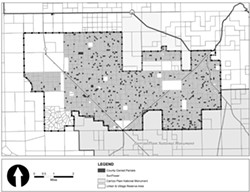It’s easy to see that Caryn Maddalena really wants to make a sale.
Maddalena is the real property manager for San Luis Obispo County General Services Agency, the local governmental wing responsible for the county’s buildings and property. Since 1988, the county has been acquiring tax-defaulted properties in the California Valley: 2.5-acre plots that were acquired through county policies and now have deed restrictions that prevent development.

- PHOTO COURTESY OF SLO COUNTY
- SHOTGUN APPROACH? : SLO County hopes to sell 415 tax-defaulted parcels in California Valley to solar companies that must now provide protected habitat. But the scattered shotgun-pattern of the properties has some people wondering whether the land would be a good deal.
To date, SLO County has gathered 415 of these parcels from California Valley, one of a few so-called “uneconomic subdivisions” in the area.
Translation: It’s worthless, more or less.
But there are some people who think they can spin those parcels—1,052 acres’ worth—into $1.9 million for county coffers by selling the whole package to one of two solar companies that now need land to offset the impacts of their projects.
“We’re thinking this would be a win for everybody,” Maddalena said.
Others agree the deal is a win-win.
“The best case scenario here would be if the solar companies bid and win,” Sierra Club Santa Lucia Chapter Director Andrew Christie told New Times in an e-mail. “The acquisition of land parcels in the vicinity of their proposed projects is how they should be meeting their mitigation burden, and nobody should expect the county to give it away.”
It could also be a crappy deal.
“My biggest problem with it is they’re supposed to be mitigation lands for impacts, but they’re highly fragmented,” said North County Watch President Sue Harvey.
Or the deal could be nothing more than a pipe dream.
As of this printing, the county has received no bids, and it’s cost about $30,000. Ordinarily, these properties, generally acquired through property tax defaults, are auctioned to adjacent property owners one at a time. However, the California Valley properties were bundled into one package in the hopes of a financially corpulent buyer.
The package originally was put up for an auction ending Aug. 2. With no potential buyers, county supervisors voted to extend the auction to Sept. 20.
Solar companies SunPower and First Solar could be the most likely buyers—at least that’s the hope. Both companies have been approved to build utility-grade solar facilities in the largely vacant California Valley subdivision north of the Carrizo Plains conservation area. Though the projects have encountered a fair amount of controversy—both were appealed to county supervisors and litigated—the likely end result seems SunPower and First Solar will build more than 8,000 acres of solar-power facilities, combined.
That much construction in a sensitive habitat like the Carrizo means the companies also have to put a lot of land into permanent preservation. The area has been touted as a prime habitat for the endangered kangaroo rat and San Joaquin kit fox, both of which could be disrupted by the construction of large solar arrays.
Under a recent settlement agreement, the companies have agreed to provide 26,000 acres of permanently protected habitat to offset the impacts of their projects.
For the county’s General Services Agency, the arrival of these land-hungry companies is both serendipitous and potentially a financial life-saver, especially with the county’s bankroll in a severe drought in recent years.
“Basically, the power companies have created more of a market out there,” Maddalena said.
Indeed, at $1.9 million, it could be one hell of a market. If the sale goes through, either to a solar company or some other buyer, General Services would be freed of its annual $15,000 payments to the California Valley Community Services District for road assessments. The agency has also asked to recoup roughly $30,000 in costs it’s put toward packaging all the properties for sale. Another $150,000 would be used to repay the agency for money that’s been cut from its Countywide Community Building Renovations fund. The remaining $1.72 million would go toward expenses for county buildings.
It could be seen as a win-win: The county gets to dump its collection of vacant land and pick up some extra cash, and the solar companies get their mitigation lands.
“We’d consider land permanently dedicated as habitat for kit foxes, burrowing owls, and kangaroo rats to be a long way from worthless,” Christie told New Times. “It couldn’t happen to a nicer uneconomic subdivision.”
Except that the properties are scattered throughout the valley in a shotgun-blast pattern, making the package questionable as suitable habitat. Because of the gaps between the parcels, might not appease the entire environmental community.
“To consider that as suitable mitigation on a one-to-one basis … is ludicrous,” Harvey said.
She added: “The point is, since they’re selling it in bulk and it’s fragmented like that … who is going to buy it but SunPower? So why would they bid on it at $1.9 million?”
More so, the land can’t be developed, raising the question: What’s being protected? The county’s parcels have deed restrictions. In other words, the land is already protected, and changing hands wouldn’t change its status as open space, at least as it sits today.
County Senior Environmental Planner John McKenzie said the county is still working with Fish and Game and the U.S. Fish and Wildlife Services to finalize the off-site mitigation lands. However, he said the county’s package would qualify if one of the companies buys it.
A SunPower representative didn’t respond as to whether the company planned to bid on the property.
If no one bids, the county will tuck tail and split the bundle back into individual parcels to auction off one by one. ∆
News Editor Colin Rigley can be reached at [email protected].
Comments